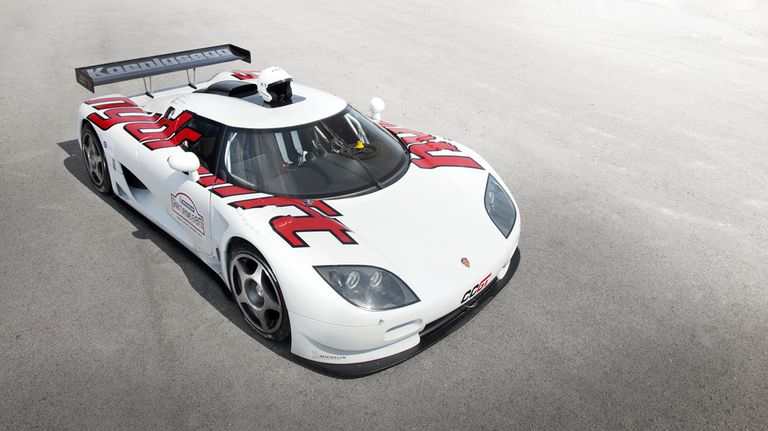Search the Community
Showing results for tags 'limited production'.
-
<Why Koenigsegg Never Went Racing, And Why It Doesn't Plan to Start Christian von Koenigsegg explains why his cars have never competed at Le Mans, and why he doesn't intend to participate in the new Hypercar class. KOENIGSEGG Despite building some of the most innovative supercars on earth, Koenigsegg does not currently have a racing team. That's not for lack of trying: Founder Christian von Koenigsegg actually built a viable race car with intent to compete at the 24 Hours of Le Mans when his company was in its infancy. But it never happened, and during a lengthy conversation with the man behind the Swedish performance car company, we learned more about why his Le Mans ambitions fell apart—and whether he hopes to try again. In 2007, Koenigsegg built a fully-functional race car that exactly followed the FIA's Group GT1 rules. The race car, called CCGT, bore a strong resemblance to Koenigsegg's second production model, the CCR. But its roots went back even further, to the very first prototype Koenigsegg built, called CC. As explained on a Koenigsegg company blog post, the original CC, and the race car it spawned, was designed to fit exactly into GT1's dimension requirements: The car could be two meters wide at the maximum, and the cockpit had to span 70 percent of the vehicle's overall width. It had a dry weight of 2200 pounds (significantly below the minimum weight for GT1, which would mean adding ballast to reach the required weight) and was powered by a naturally aspirated V-8 making well over 600 horsepower. But two months after the CCGT's first shakedown runs, the ACO and FIA had a change of heart. The governing bodies banned carbon-fiber monocoque construction, which was used in every Koenigsegg road car and thus formed the basis of the CCGT. The regulators also raised the minimum production requirement dramatically. Previously, an automaker was required to construct 20 street-legal examples of a model, in total, to be eligible to race. After the 2007 change, that number rose to 350 cars per year, impossible for a tiny automaker like Koenigsegg to achieve. The CCGT was ruled out of the class before it ever competed in a single race. The only Koenigsegg CCGT ever built. | KOENIGSEGG "We were aiming to go racing in the GT1 series, which was perfect for our type of cars—road-going hypercars turned race cars" von Koenigsegg told Road & Track during a recent, lengthy conversation. "Then they shut it down right when we were about to go racing, which was very annoying. Since then, there hasn't been any series for these types of cars." The rule change left von Koenigsegg without a place to take his supercars racing. "Even if we would be allowed to go to the highest level of GT racing, we would be competing against Porsche 911s and Ferrari 488s"—sports cars built to vastly different performance goals than Koenigsegg's cars, which commanded well over half a million dollars each. Even if von Koenigsegg had wanted to compete in such a class, he worried that his cars would be "completely downgraded through Balance of Performance via restrictors, because we are not supposed to be any faster. And then it would be just a super-expensive racing car, which would cost more to repair than a 911, and we might even get beaten by a 911 because of BoP, while in reality, they are completely different vehicles. That doesn't make any sense." So Koenigsegg's racing dreams died in 2007, before they could ever become real. But what about today? The WEC's new Hypercar class debuted this year, and it was seemingly built for exactly the kind of extreme vehicles that Koenigsegg builds. But the man behind the Swedish supercar company is unconvinced. "Of course, they started this Hypercar series at Le Mans, but in the end it turned out to be some kind of LMP car again, so it's just a new name for the same kind of thing, more or less." Does von Koenigsegg see a racing future for his cars? Not under the current rules. "The alternative, I guess, is to build some kind of a Le Mans Prototype, which has no relation to our road cars, which I don't find too appealing. I would like to go back to the GT1 type of class, where we [could] see Bugattis, Paganis, Koenigseggs—modified road cars featuring completely different technologies. Not this silhouette racing where you have the same chassis under different bodies. Granted, it would be a very expensive series, given the price of these cars, but then we could build up on what we have. Everyone could showcase something you could actually buy, if you're extremely wealthy. That's what we would like, but I'm not sure if it could ever happen.">
- 3 replies
-
- 2
-

-
- koenigsegg
- ccgt
-
(and 27 more)
Tagged with:
- koenigsegg
- ccgt
- ccr
- fia
- gt1
- le mans
- prototype
- racing
- motorsport
- aco
- wec
- homologation
- limited production
- endurance
- 24 hours
- silhouette
- race cars
- balance of performance
- bop
- federation internationale de lautomobile
- automobile club de louest
- world endurance championship
- supercars
- hypercars
- sports cars
- lmp1
- lmh
- interviews
- christian von koenigsegg
-
Supercar maker McLaren has released the details of the production version of the P1 prior to its debut at the Geneva Motor Show. Only 375 units will be produced instead of the originally planned 500 copies to maintain the car's exclusivity. The P1 is motivated by a hybrid powertrain consisting of a twin-turbo, 3.8-litre V8 generating 737bhp with 720Nm of torque and an electric motor producing 179bhp and 260Nm. The engine is mated to a seven-speed dual-clutch automatic gearbox which sends power to the rear wheels. The P1 has a carbon fibre chassis which weighs 100kg, which is the lightest ever installed on a road-going car. According to McLaren, it is capable of providing the safety and rigidity of an F1 vehicle. The slippery P1 has a CD figure of 0.34 and can generate 600kg of downforce, which is five times more than the MP4-12C. The super car is fitted with an Instant Power Assist System (IPAS). According to McLaren, the IPAS is the electric motor which can be activated via a steering wheel-mounted button that gives the P1 the throttle response of a normally-aspirated engine. With the IPAS on, the P1 reaches 100km/h from standstill under 3 seconds and achieves 200 km/h within 7 seconds.
-
On October 21, 2009, the production version of the Lexus LFA was unveiled on the first press day of the 41st Tokyo Motor Show. Introduced by Akio Toyoda at a press conference, it was disclosed that the vehicle would be limited to 500 production copies. Some three years later, the 500th unit of the LFA supercar has finally rolled off the production line at Japan's Motomachi Plant. A plaque showing the car's build number confirms this is the 500th LFA. It is time to bid farewell to the 552bhp V10 Japanese coupe. Chief engineer, Haruhiko Tanahashi, said, "I've lived and breathed supercars for the past decade. Specifically one supercar, LFA. Very few people have the opportunity we had to create a world-class supercar from a blank sheet of paper." This last LFA comes equipped with the Nurburgring Package. Given the high cost of construction and limited production, analysts do not expect LFA sales to be profitable. However, the coupe is intended to serve as a test-bed for new car technologies, including carbon fiber mass-production, and related performance vehicle development.
-
- super cars
- other news
- (and 8 more)
-

Aston Martin to unveil production V12 Zagato at the Kuwait Contours d' Elegance
SYF77 posted a blog entry in MyAutoBlog
[extract] It will be at Kuwait Contours d' Elegance on 15 February 2012 that British sportscar manufacturer, Aston Martin will be launching their new limited edition V12 Zagato. The car will be launched along with Premier International Motors Group, Aston Martin's dealer and partner based in Kuwait. The Zagato has an all- aluminium carbon fibre body and is propelled by a 6.0 liter V12 engine producing a maximum power of 510 bhp and 570 Nm torque. The V12 Zagato will be priced from-
- new model
- super cars
- (and 8 more)
-
According to a recent report, Ferrari will form an owners' club and give its members first crack on the ludicrously expensive limited-edition Ferraris that roll out from time to time. Last year, the Italian automaker announced plans to build 80 units of the SA Aperta (shown above), a roadster derived from the 599 GTB coupe. But many long-time Ferrari collectors complained that these limited edition cars were snapped up before they had a chance to act. The SA Aperta was unveiled at a customer-only event in August 2010 at the Pebble Beach Concours d'Elegance. It was then displayed publicly at the Paris Auto show the following month. The cars were sold out by the end of September 2010. Speaking with Automotive News Europe, Ferrari CEO Luca Cordero di Montezemolo said "I do not want our faithful collectors to miss the opportunity to buy one of our special series." He declined to divulge details, but speculation suggests the club could be limited to customers who already own five Ferraris. The company says there are about 300 people worldwide who can make that claim. One such person that I can think of is Hong Kong Singer, Aaron Kwok. According to Wikipedia, Kwok owns a F50, F512M, F355 GTS, F360 Modena and F599 GTB Fiorano. Do you know of any Singaporeans who can qualify to join the exclusive club ?
- 3 comments
-
- super cars
- events
- (and 10 more)


